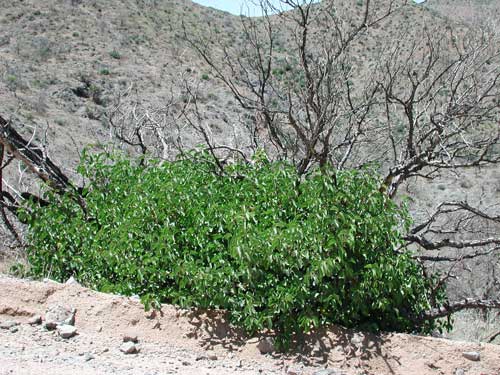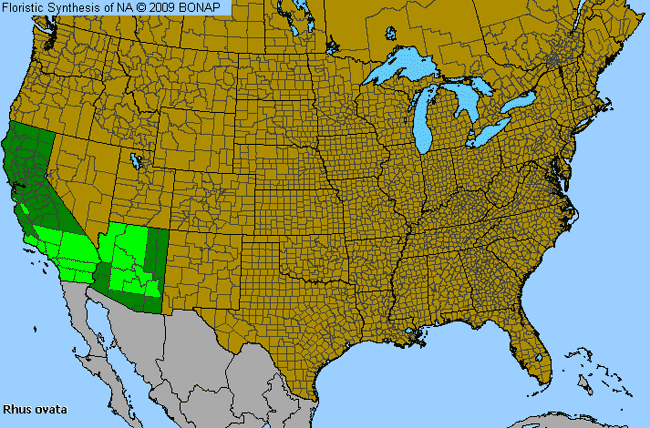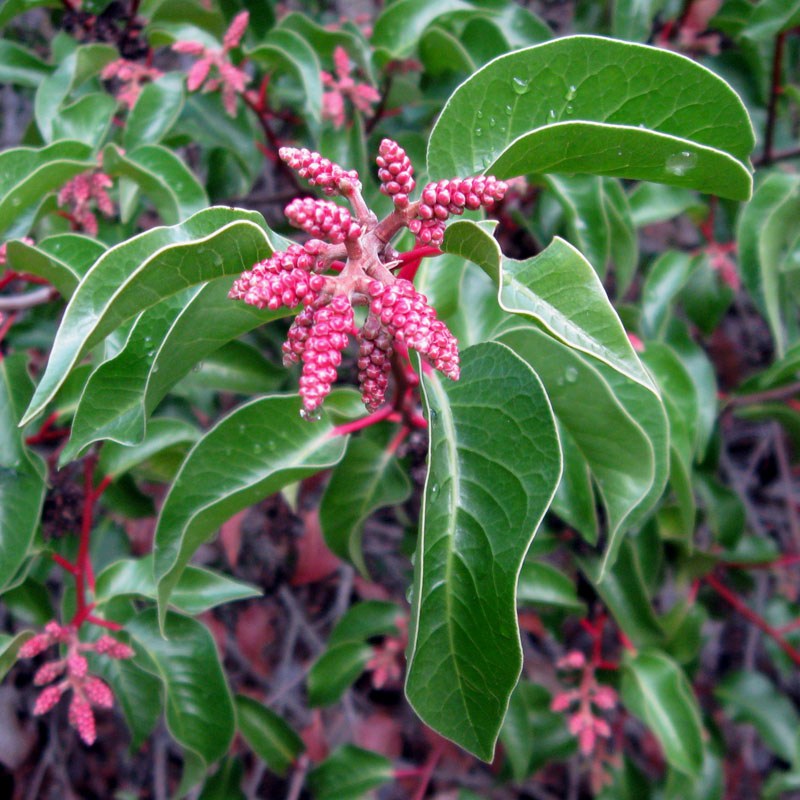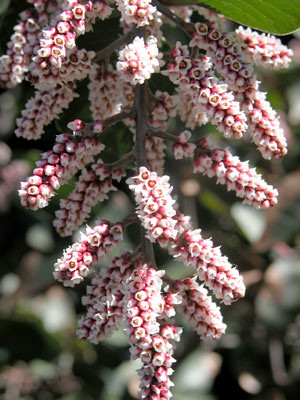
There are a number of views in the back-country towards the mountains and high deserts of southern California or even the mountains and high country of Arizona/New Mexico where you might see this often ignored and taken for granted beautiful chaparral community which when all other shrubs seem drought dormant and rangy looking, this one stands out as a rich shiny waxy green bush with taco shelled shaped leaves. Take a look at some common shots you may now recognize but have ignored in the past as you sped by down the road no doubt on your way to 'Party Hardy Marty' at 'Blow-Sand' in Ocotillo Wells, 'Glamis Sand Dunes' or onto 'Martinez Lake' at the Colorado River near Yuma, AZ.
 |
| photos: Lee Dittman |
Here's it most common distribution
Like many natives, this one has interesting colours and ornamental value as far as variety of colours and growth as the year progresses. Here are what it looks like before bud break or bloom.
Here it is in flowers which are finally in bloom.
And finally here it is with fruits or seeds. For those familiar with it, it should remind you of the Lemonade Berry Seeds which is a related cousin.
As another one of those important qualities, this is yet another shrub that will spring back from a brush fire. Many non-native ornamental plantings will not do this. You have to go purchase more planting stock and that will take more than twice as long to rebuild what has been lost in the landscape.
 |
| Photo by mjplagens |
So exactly what can a gardener/Landscaper do with a Sugar Sumac (Rhus ovata) ? First let's take the formal shrub replacement ideas. Here's what Tree of Life Nursery suggests.
EXCELLENT SUBSTITUTE FOR:
Ligustrum
Myoporum
Oleander
Photinia
Pittosporum
Raphiolepis
Xylosma
For the moment I'll just deal with Oleander Bush and reasons for Rhus ovata as it's replacement. In Southern California these were very common along the Interstates as landscaping screens and most often it was easily viewed in the median as an oncoming head lights barrier screen. Unfortunately something happened to them in the way of a slow death cause by some blight. This shrub and many other chaparral species should be considered a good replacement for other non-natives for just such a common utility function because once established and especially with a mycorrhizal grid intact, such plantings should become drought resistant or at least tolerant with less water if any at all becoming unnecessary. This of course changes with regards to location. In the deserts southwest in the USA, you most likely will have to deeply water at least once a month or possibly every two weeks depending on the location and circumstances. Even where I have seen it on the desert floor in a wash around Anza Borrego State Park, there was permanent water under the sand. Nevertheless it's an important planning point in view of the high cost of water and even it's future availability to the southwest. Many folks will want a formal look, maybe even having one as a specimen shrub or small tree and that's fine.
However my personal choice is creating more natural settings or themes out in the landscape. Today there are numerous newer housing or Condo developments which through structuring smaller landscapes has given themselves far more profit than those homes built in the 1950s with the large lots for large family backyard designing. Hence many small yards won't take large trees. In some cases the yards are just to narrow. Over here in Europe, small tiny cramped backyards are common, but worse than that is having towering apartment buildings and nosey neighbours seeing your every move in the garden, absolutely no privacy. Even when I was a landscaper in Southern California some of our properties were Mobile Home Parks with very little room for larger trees and shrubs.
My next post will detail my experiences growing up in coastal chaparral country and how this unique world and exploring it's dry washes and stream beds or climbing rock knoll outcroppings on hill tops with trees as a kid gave miniature woodlands of dwarfed chaparral me later on in life some insight on the landscape possibilities of the chaparral which has inspired in me with creative ideas on replicating some of the tiny hidden world environments for small spaces called "Elfin Forests" or "Pigmy forests".
 | |
| Texas Madrone (Arbutus xalapensis) |
Guadalupe Mountains
For a further take or perspective on Sugar Sumac or Sugarbush Rhus ovata and it's uses, please see the blog entry by Landscape Professional David Cristiani of Albuquerque's Quercus Group at
http://desertedge.blogspot.se/2011/02/deceptively-lush.html




Thanks for the link!
ReplyDeleteSugarbush is my favorite plant from the So Cal interior chaparral. I cannot imagine anyone liking photinias after seeing one Rhus ovata! Great post
Bob Baran of anzaborrego.net is going out that way to Dos Cabezas Spring in a couple of weeks and hopefully I'll get a snap shot to link to for illustrating an area of it's habitat that often gets over 110 degrees.
DeleteI've got numerous drafts waiting in the wings, one of which is on Lemonade Berry and Pink Flowering Sumac, but they are mostly a coastal chaparral. Not sure how they would do in deserts. I don't think it would be a heat issue as much as a frost and freeze issue and I know that even in the southwestern desert bad freezes are possible.
See you next week, off for Krakow Poland in about two hours.
Kevin
Thank you for the info....I know about this plant but I've never used it in the garden. I guess because I'm using Xylosma and Oleander for hedges. But I like how you mentioned the Oleander Scorch and replacement. This plant does very well here and can be seen in a lot of yards around Tucson.
ReplyDeleteThe picture at the bottom of the post is the Gudalupe Mountains of southern New Mexico, but it illustrates Elfin Forest habitat, something I grew up around in chaparral country. I love recreating small private habitats for customers, or at least I use to when living there.
DeleteCheers, Kevin
BTW, the small trees in that picture I referenced are Texas Madrones. Below them are Manzanitas.
The sugarbush (Rhus ovata)is a beautiful bush. The berries are pretty and colorful. I wish it grew in Maryland. The most common native bush in my area is the mountain laurel. Great post.
ReplyDeleteI know they can take bitter cold, at least I know this from first hand experience. It's always fun to sometimes experiment though.
DeleteNot a sumac I'm familiar with, and not hardy in our area, but very pretty!
ReplyDeleteOn my property in Anza, CA we had temperatures down to 6- Fahrenheit from 1985 to 1987. I remember those winters which brought blasts of fridgid Canadian air down from the north that was picked up by an unuasual High Pressure Santa Ana wind condition. Those winds were almost hurricane force winds that blew steadily for days and days. I hated those times. My house was almost one mile high so you can imagine just how bad the winds were.
DeleteEven the deserts below weren't spared. The Coachella Valley lost many of it's citrus orchards. However the natives, including Rhus ovata faired wonderfully. Your Sumacs are of the deciduous kind back there (gorgeous in the fall) and yes they have an entirely different look about them. You could always experiment with a speciman Rhus ovata and report back to us with an article. *smile*
Great post, Kevin. Although sugarbush can be found on the nearby Santa Rosa Plateau, we only have the more common Laurel Sumac (Malosma laurina) growing on our site, which I still often inadvertently refer to as Rhus laurina out of sheer habit because I can't seem to keep up with the constant taxonomic changes our botanists like to wreak on us regular folk :)
ReplyDeleteI did plant a couple one gallon sugarbushes and one lemonadeberry about three years ago on the property, and they are doing well so far - not really fast growers, but they have adapted well and are doing swimmingly without any supplemental irrigation. You are so right - these versatile, hardy and very attractive native shrubs should be more used more widely in the landscape, freeway median and otherwise! Btw, are you familiar with Mission Manzanitas (Xylococcus bicolor)? We have two beautiful specimens growing on our property - one is a small tree at about 8' tall, and the other is a smaller-sized shrub growing under an Engelmann oak. Like their manzanita cousins, they have beautiful bark, but also produce some unusual fruit that look like an odd cross between olives and elderberries. I had never seen them before until we moved out here. Per Jepson, they appear to be endemic to the South Coast and Catalina Island.
Wow, I never really thought of Laurel Sumac and Lemonade Berry as being up there, but at least if they are you know you are in a banana belt type of growing area. It must be great living in La Cresta area next to the Santa Rosa Plateau, I love that place. Over development was always a problem by developers liking their chops for pristine raw land.
DeleteMission Manzanita was always by the coast for me in San Diego area. The closest it came towards us in nature was Cowels Mountain northwest of Fletcher Hills. Manzanita is one type of plant I miss. There's really nothing to compare it to here.
Guess I should do some Swedish countryside nature posts soon. That is if it ever becomes spring again. Trees are barely swelling their buds. It's a strange year here.